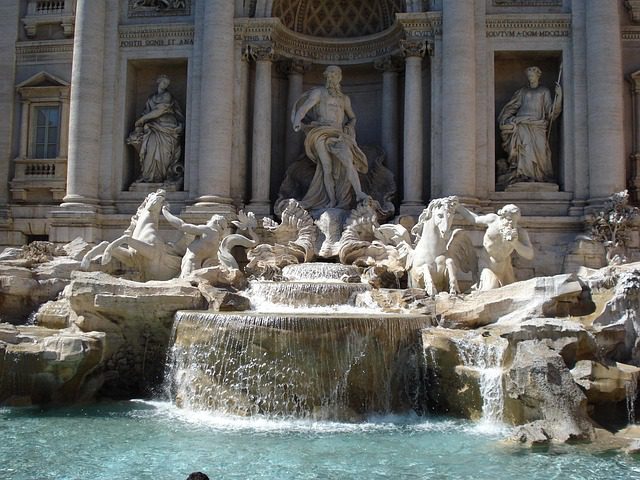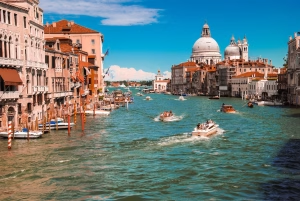Italy woos visitors with its rich history, art, and culture tapestry. But even in this land of la dolce vita, tourists make common mistakes that can be easily avoided. It pays to be aware of local customs, laws, and sensitivities to ensure a smooth, hassle-free trip.
Here’s a comprehensive look at 21 crucial things not to do in Italy, from respecting historical sites to avoiding fashion faux pas.
- 1. Do Not Visit The Trevi Fountain In Rome Without Queuing
- 2. Do Not Sit Down On Rome’s Spanish Steps
- 3. Do Not Take Photos Inside The Vatican’s Sistine Chapel
- 4. Do Not Eat On Florence’s Historic Streets During Restricted Hours
- 5. Do Not Feed Birds In Venice’s Piazza San Marco
- 6. Do Not Engage in Domestic Activities At Historical Sites
- 7. Do Not Consume Food Or Drink at Famous Monuments
- 8. Do Not Damage Historical Sites By Carving Or Littering
- 9. Do Not Visit Venice Without A Pre-Booked Entry Fee
- 10. Do Not Set Up Picnics In Venice’s Public Spaces
- 11. Do Not Swim Or Bathe In Venice’s Canals
- 12. Do Not Ride Bikes In Venice’s City Center
- 13. Do Not Drink Alcohol Outdoors At Night In Cities Like Rome
- 14. Do Not Participate In Group Celebrations In Venice On Weeknights
- 15. Do Not Join Banned Pub Crawls In Rome
- 16. Do Not Busk On Rome’s Public Transport
- 17. Do Not Drink From Non-Glass Containers In Parks After Midnight
- 18. Do Not Touch The Spouts Of Rome’s Public – Nasoni Fountains
- 19. Do Not Attach Love Locks To Restricted Bridges
- 20. Do Not Smoke Outside Designated Zones, Especially In Milan
- 21. Do Not Fly Drones Over Urban Areas Without Permits
- Why Choose OneVasco?
- FAQs
1. Do Not Visit The Trevi Fountain In Rome Without Queuing
Since December 2024, access to Rome’s Trevi Fountain is limited to 400 people daily from 9 am to 9 pm, with entry via the central staircase only. Avoid fines by queuing and visiting off-peak hours.
2. Do Not Sit Down On Rome’s Spanish Steps
Since 2019, sitting on the Spanish Steps has been banned to preserve the monument, with fines ranging from €250-400 (Rs. 22,000-36,000). It’s also prohibited to drag wheeled objects like strollers, scooters, or suitcases up or down the steps to avoid damage.

Suggested Read:Italy Visa Appeal For Indians
3. Do Not Take Photos Inside The Vatican’s Sistine Chapel
While photography is generally allowed within the Vatican Museums, it’s strictly forbidden inside the Sistine Chapel, home to Michelangelo’s masterpiece frescoes. Guards vigilantly enforce this rule to preserve the art and maintain a sacred atmosphere.
4. Do Not Eat On Florence’s Historic Streets During Restricted Hours
Florence has banned eating on certain streets in its historic center from 12-3 pm and 6-10 pm to reduce litter and crowding. Fines apply for violators. Enjoy street food at restaurants or in parks during these hours.
5. Do Not Feed Birds In Venice’s Piazza San Marco
While the friendly pigeons of St. Mark’s Square are an iconic sight, feeding them is strongly discouraged. In 2008, Venice imposed fines for feeding pigeons in an attempt to control their population and keep the square clean.

6. Do Not Engage in Domestic Activities At Historical Sites
Avoid treating Italy’s historical monuments like extensions of your home by engaging in everyday domestic activities. In 2019, two German tourists were fined €950 (Rs. 86,000) for brewing coffee on a portable stove under Venice’s Rialto Bridge. Picnicking or napping on monuments can lead to fines—stick to designated areas instead.
7. Do Not Consume Food Or Drink at Famous Monuments
Many Italian cities like Rome and Venice have laws against eating or drinking at historical locations to preserve their cultural significance. Avoid snacking at these revered sites.
Suggested Read:Italy in January
8. Do Not Damage Historical Sites By Carving Or Littering
It’s illegal to carve names, initials, or any other graffiti into historical monuments. This is considered defacement and can lead to prosecution. Similarly, do not litter at cultural heritage sites. Such actions disrespect Italy’s rich history.
9. Do Not Visit Venice Without A Pre-Booked Entry Fee
On days when Venice charges an entry fee, usually during peak season, do not arrive without pre-booking. The fee for day-trippers has increased to €10 (Rs. 900) in 2025. Check official sources and plan ahead to avoid issues.
10. Do Not Set Up Picnics In Venice’s Public Spaces
Venice has limited green spaces, so setting up picnics in public areas like campi (squares) or along canals is not permitted. Avoid perching on monuments like wellheads or bridges to snack, as this is one of the key things not to do in Italy’s tourist hotspots.

11. Do Not Swim Or Bathe In Venice’s Canals
As enticing as they may look on a hot summer day, Venice’s canals are strictly off-limits for swimming or bathing. Not only is the water unhygienic due to pollution, but diving in also disrupts boat traffic and can lead to injury.
12. Do Not Ride Bikes In Venice’s City Center
Cycling is banned in Venice’s city center to avoid accidents and protect structures. Park your rental at designated lots on the outskirts and explore the floating city on foot. If you need a break from walking, hop on a Vaporetto water bus instead.
13. Do Not Drink Alcohol Outdoors At Night In Cities Like Rome
Cities like Rome restrict drinking alcohol outdoors during late hours, usually after midnight, to reduce noise and maintain public order. Enjoy your drinks inside bars or restaurants instead.
14. Do Not Participate In Group Celebrations In Venice On Weeknights
Group celebrations in Venice like bachelor/bachelorette parties are only allowed outdoors on weekends. Weeknight revelry must be contained to indoor venues. Keep your party crew’s chants and cheers to a respectful volume, especially in residential areas.
15. Do Not Join Banned Pub Crawls In Rome
Some Italian cities, like Rome, have banned organized pub crawls to combat drunken behavior and noise pollution. Participating in a commercial pub crawl can result in fines for both organizers and attendees.
Suggested Read:Festival in Italy
16. Do Not Busk On Rome’s Public Transport
Playing music or busking on Rome’s buses, trams, and metros is prohibited to ensure a pleasant travel experience for all passengers. Save your tunes for designated spots in piazzas or streets.
17. Do Not Drink From Non-Glass Containers In Parks After Midnight
Many urban green spaces ban drinking from non-glass containers like cans or plastic bottles after midnight to curb littering. Stick to enjoying your beverages before the cutoff time.
18. Do Not Touch The Spouts Of Rome’s Public – Nasoni Fountains
When quenching your thirst at Rome’s “nasoni” drinking fountains, don’t let your mouth touch the spout. Create an arc with your finger to sip the water stream instead. This maintains hygiene for all users.
19. Do Not Attach Love Locks To Restricted Bridges
The trend of attaching padlocks to bridges as a symbol of eternal love has swept many cities, often to the detriment of historic structures. In Venice, attaching locks to the Rialto Bridge or Accademia Bridge is strictly forbidden and can incur fines of up to €3,000 (Rs. 2,70,000). Similarly, Rome has banned locks on the Ponte Milvio.

20. Do Not Smoke Outside Designated Zones, Especially In Milan
As of January 2025, Milan has banned smoking in outdoor public spaces, including parks, beaches, and bus stops. Other cities have designated smoking and non-smoking zones, often marked by signs. Always dispose of cigarette butts properly in ashtrays or bins to avoid littering fines.
21. Do Not Fly Drones Over Urban Areas Without Permits
Aerial photography and videography can capture stunning perspectives of Italy’s landscapes and landmarks. However, flying drones over cities and historical sites is heavily regulated. Permits are required from both ENAC (Italian Civil Aviation Authority) and local municipalities.
Why Choose OneVasco?
OneVasco makes visa applications effortless. Our expert team manages the entire process, allowing you to focus on your journey.
Enjoy stress-free travel with fast visa approvals.
-
Expert and Personalized Support
-
Efficient and Hassle-Free Process
-
Real-Time Tracking and Updates
-
Transparent Communication
-
Trusted by Millions
FAQs
What are the laws in Italy for tourists?
Italy has several regulations for visitors, such as no eating/drinking at historical sites, no swimming in Venice’s canals, no smoking outdoors in Milan, and restrictions on monument entry. Respect these rules to avoid fines.
Is it ok to wear shorts in Italy?
Shorts are generally acceptable but dress modestly when visiting churches or religious sites. Cover knees and shoulders to show respect.
Can unmarried couples go on holiday to Italy?
Yes, unmarried couples can travel together in Italy without any restrictions. All tourists are welcome regardless of marital status.
Is it safe to visit Italy as a solo traveler?
Italy is considered safe for solo travelers, but exercise caution and stay aware of your surroundings as you would anywhere else. Take basic safety precautions and you’ll have a great trip!
What is the best month to go to Italy?
Spring (April-May) and autumn (September-October) are ideal times to visit Italy for pleasant weather and fewer crowds. However, the best time depends on your preferences and itinerary.
Can two male friends share a hotel room in Italy?
Of course! There are no restrictions on same-gender friends sharing hotel rooms. Italy welcomes all travelers warmly.
What is not allowed in Italy as a tourist?
Some prohibited activities include swimming in canals, smoking outdoors in Milan, eating at historical monuments, and littering at cultural sites. Follow posted signs and local guidelines.
What are the strict rules in Italy?
Italy has firm regulations on things not to do in Italy, like damaging historical sites, eating at monuments, swimming in Venice’s canals, and visiting attractions without pre-booking. Follow these rules to avoid penalties and help preserve Italy’s heritage.





















